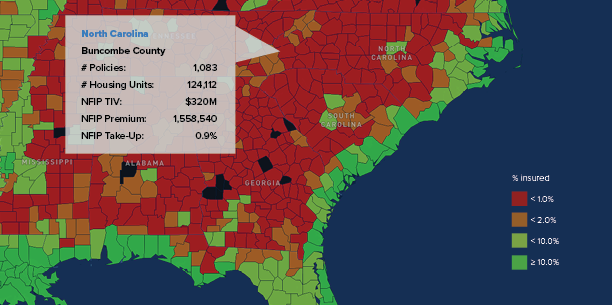By Lewis Nibbelin, Contributing Author, Triple-I
Spanning over 500 miles of the southeastern United States, Hurricane Helene’s path of destruction has drawn public consideration to inland flood threat and the necessity for improved resilience planning and insurance coverage buy (“take up”) to confront the safety hole.
Excessive rainfall and wind inflicted a mixture of catastrophic flooding, landslides, and excessive rainfall and wind gusts dumped an unparalleled 40 trillion gallons of water throughout Florida, Georgia, North Carolina, South Carolina, Virginia, and Tennessee, inflicting a whole bunch of deaths and billions in insured losses.
Most losses are concentrated in western North Carolina, with a lot of Buncombe County – residence to Asheville and its historic arts district – left just about unrecognizable. Torrential rain and mountain runoff submerged Asheville below practically 25 toes of water as rivers swelled, whereas neighboring communities have been equally flattened or swept away.
Rebuilding will take years, particularly as widespread lack of flood insurance coverage forces most victims to hunt federal grants and loans for help, slowing restoration. Compounding these challenges, misinformation about help from the Federal Emergency Administration Company (FEMA) has impeded support operations in sure areas, main FEMA to concern a reality sheet clarifying the fact on the bottom.
A persistent safety hole
Lower than 1 p.c of residents in Buncombe County had federal flood insurance coverage as Helene struck, as illustrated within the map beneath, which is predicated on Nationwide Flood Insurance coverage Program (NFIP) take-up charge knowledge. Inland flooding isn’t new, and neither is the inland flood-protection hole.

In August 2021, the Nationwide Climate Service issued its first-ever flash-flood warning for New York Metropolis as remnants of Hurricane Ida introduced rains that flooded subway strains and streets in New York and New Jersey. Greater than 40 folks have been killed in these states and Pennsylvania as basement flats all of a sudden stuffed with water.
Then, in July 2023, a sequence of intense thunderstorms resulted in heavy rainfall, lethal flash floods, and extreme river flooding in jap Kentucky and central Appalachia, with hourly rainfall charges exceeding 4 inches over the course of a number of days. Subsequent flooding led to 39 fatalities and federal disaster-area declarations for 13 jap Kentucky counties. In line with FEMA, only some dozen federal flood insurance coverage insurance policies have been in impact within the affected areas earlier than the current storm.
“We’ve seen some fairly important adjustments within the affect of flooding from hurricanes, very far inland,” Keith Wolfe, Swiss Re’s president for U.S. property and casualty, instructed Triple-I CEO Sean Kevelighan in a Triple-I Government Change. “Hurricanes have simply behaved very otherwise prior to now 5 years, as soon as they arrive on shore, from what we’ve seen prior to now 20.”
Want for schooling and consciousness
Low inland take-up charges largely mirror shopper misunderstandings about flood insurance coverage. Although roughly 90 p.c of all U.S. pure disasters contain flooding, many householders are unaware that an ordinary householders coverage doesn’t cowl flood injury. Equally, many consider flood protection is pointless until their mortgage lenders require it. It additionally shouldn’t be unusual for householders to drop flood insurance coverage protection as soon as their mortgage is paid off to economize.
Greater than half of all householders with flood insurance coverage are lined by NFIP, which is a part of the FEMA and was created in 1968 – a time when few non-public insurers have been keen to write down flood protection.
Lately, insurers have grown extra snug taking up flood threat, thanks largely to improved knowledge and analytics capabilities. This elevated curiosity in flood amongst non-public insurers gives hope for improved affordability of protection at a time when NFIP’s Danger Score 2.0 reforms have pushed up flood insurance coverage premium charges for higher-risk property house owners.
New instruments and methods
New instruments – similar to parametric insurance coverage and community-based disaster insurance coverage – additionally provide methods of enhancing flood resilience. In contrast to conventional indemnity insurance coverage, parametric buildings cowl dangers with out the problems of sending adjusters to evaluate injury after an occasion. As an alternative of paying for injury that has occurred, it pays out if sure agreed-upon circumstances are met – for instance, a particular wind pace or earthquake magnitude in a specific space. If protection is triggered, a fee is made, no matter injury.
Pace of fee and decreased administration prices can ease the burden on each insurers and policyholders. Alone, or as a part of a bundle together with indemnity protection, parametric insurance coverage can present liquidity that companies and communities want for post-catastrophe resilience.
Whereas localized insurance coverage approaches can help flood resilience, coordinated investments in public schooling and preemptive mitigation are essential to lowering threat and making insurance coverage extra accessible and inexpensive. Intergovernmental collaboration with insurers on growth zoning and constructing codes, for example, can promote the creation of safer and climate-adaptive infrastructure, reducing human and financial losses.
Be taught Extra:
Eradicating Incentives for Improvement From Excessive-Danger Areas Boosts Flood Resilience
Miami-Dade, Fla., Sees Flood Insurance coverage Fee Cuts, Due to Resilience Funding
Attacking the Danger Disaster: Roadmap to Funding in Flood Resilience

